GYEONGJU FULL-DAY TOUR
-
- Price
- 230,000 KRW / Person
- Minimun Pax
- 4 People
- Time
- Daily 08:00am ~ 21:00pm
- Inclusion
- Return KTX Tickets (Seoul-Gyeongju-Seoul), Transportation & English-speaking Tour Guide (Gyeongju), Admission Fees, Lunch, VAT.
- Exclusion
- Hotel Pick-up/Drop-off Services, Dinner, Personal Expenses.
Tour Course
-
- Seoul Station: KTX Train (08:00am-10:18am)
- Arrive at Shin Gyeongju Station: Meet our Guide
- Seokguram Grotto
- Lunch (Bibimbap)
- Bulguksa Temple
- Cheomseongdae Observatory
- Daerengwon
- Shin Gyeongju Station: KTX Train (18:59pm-21:13pm)
- Arrive at Seoul Station.
Highlights
-
-
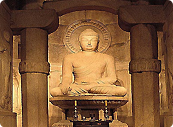
-
- Sukgulam Grotto
-
Seokguram, located on Mt. Toham, is the representative stone temple of Korea. The official name of Seokguram, National Treasure No. 24, is Seokguram Seokgul.
Designated as World Cultural Heritage Site by UNESCO in 1995, it is an artificial stone temple made of granite. The construction was started by Kim Dae-Seong (700-774) in 751 during the reign of King Gyeong-Deok (742-765) of the Silla Dynasty (57 B.C.-A.D. 935) and it was finished twenty-four years later in 774, during the reign of King Hye-Gong (765-780).
Seokguram is known to have been built with Bulguk Temple. According to the history book Samgukyusa of the Goryeo Dynasty (the country that unified the Korean peninsula at the end of the Silla Dynasty, 918~1392), Kim Dae-Seong had built Bulguksa for the parents who were alive, and Seokguram for the parents of his former life.
Inside the round-shaped main hall, there are the Bonjon Statue, Bodhi-sattva and his disciples. Seokguram was built to preserve these statues. The Bonjon figure wearing a generous smile is seated on the stage engraved with lotus flower design. The rounded ceiling looks like a half-moon or a bow and has a lotus flower decorated cover on it.
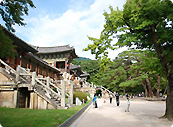
-
- Bulguksa
-
Bulguk Temple is the representative relic of Gyeongju and was designated as a World Cultural Asset by UNESCO in 1995. The beauty of the temple itself and the artistic touch of the stone relics are known throughout the world.
Bulguksa was built in 528 during the Silla Dynasty, in the 15th year of King Beop-Heung's reign (514-540). Bulguksa underwent numerous renovations from the Goryeo Dynasty (918-1392) to the Joseon Dynasty (1392-1910), but was burned down during the Imjinwaeran War (the war following the Japanese Invasion, 1592-1598).
Even today, Bulguksa is home to many important cultural relics such as Dabo-tap (National Treasure No. 20), Seokga-tap (National Treasure No. 21) Yeonhwa-gyo* Chilbo-gyo (National Treasure No. 22), Cheongun-gyo, * Baegun-gyo (National Treasure No. 23), the Golden Seated Vairocana Buddhist Figure (National Treasure No. 26), the Golden Seated Amita Figure (National Treasure No. 27), and Sari-tap (Treasure No. 61). he Dabotap (Many Treasure Pagoda) and Seokgatap (Sakyamuni Pagoda) are two of the most valued pagodas in Korea. Designated as Korean National Treasures in 1962, Dabotap (10.4 meters tall) and Seokgatap (8.2 meters tall), stand on the east and west sides of the yard separating Daeungjeon (the hall housing the Sakyamuni Buddha) and Jahamun (Mauve Mist Gate).
- Bulguksa
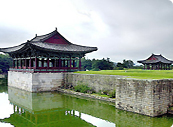
-
- Anapji Pond
-
According to the historical records of 'Samguk-sagi,' Anapji Pond was built during the 14th year of King Munmu (in power 661-681 AD) of the Silla Dynasty (57 BC-935 AD).
Small mountains were created inside the palace walls, beautiful flowers were planted, and rare animals were brought in to create an exquisitely exotic garden fit for royalty.
The pond was originally built in Wolseung Fortress (erected in 101 AD during the Silla period), but the fortress was destroyed and now lies in ruins. In 1974, an excavation project revealed large spherical shapes (measuring 200 meters in diameter and 180 meters in height) which indicated that 3 islands had been located in the pond.
- Anapji Pond
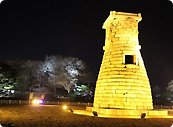
-
- Cheomseongdae Observatory
-
Cheomseongdae is the oldest existing astronomical observatory in Asia.
Constructed during the reign of Queen Seon-deok (632-647), it was used for observing the stars in order to forecast the weather. This stone structure is a beautiful combination of straight lines and curves, and was designated as National Treasure No.31 on December 20th, 1962.
The Vernal Equinox, Autumnal Equinox, Winter Solstice, Summer Solstice and the 24 solar terms (also known as the astronomical solar year) were determined by the observation of stars.
The pavilion stone is believed to have been used as a standard of deciding directions, north, south, east and west. The 362 stones used to build Cheomseongdae represented the 362 days in a lunar year.
- Cheomseongdae Observatory
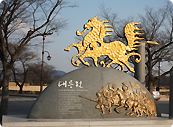
-
- Daereungwon Tomb Complex
-
Large ancient tombs of kings and noblemen of the Silla Dynasty can be seen around Gyeongju at the Daereungwon Tomb Complex (Cheonmachong Tomb). There are twenty-three large tombs located here; the most famous being Cheonmachong and Hwangnamdaechong. In an excavation of the area in the 1970's, Cheonmachong was discovered with a painting of mounted horse. This painting is the only discovered painting from the Silla Era. There are 11,526 remains and crowns of the king inside the tomb demonstrating the lavish lifestyle of the king. Another tourist attraction is Hwangnamdaechong, which is the largest ancient tomb. It houses the bodies of both the king and queen and has over 30 thousand relics and gold accessories.
The unique thing about Hwangnamdaechong is that the queen's tomb has more luxurious accessories. From that researchers have concluded that even the queen can have a high social position before marriage.
- Daereungwon Tomb Complex
-


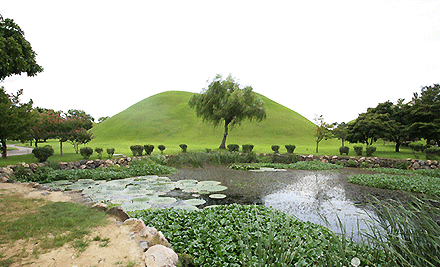

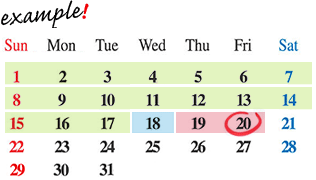

 E-mail
E-mail


























